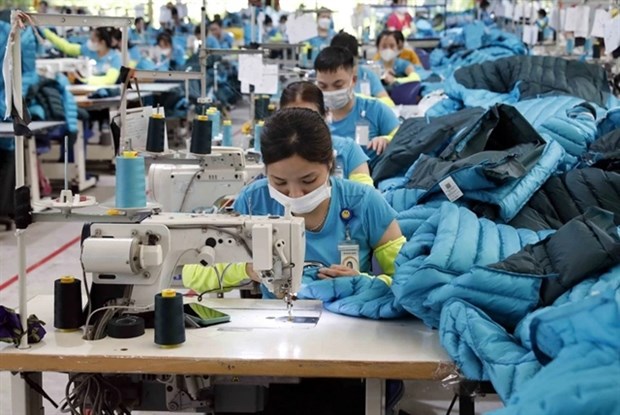Vietnam’s textiles, garments yet to fully tap FTAs’ advantages and potential

Workers at a textile and garment factory in the northern province of Bac Ninh. (Photo: VNA)
Vietnam’s textile and garment industry has not been able to fully capitalise on the advantages and potential of FTAs, according to the Ministry of Industry and Trade (MoIT).
To address this issue, the MoIT, as the leading agency for FTA negotiation and enforcement, has been enhancing connections with ministries, localities, associations, and stakeholders to establish a collaborative ecosystem to help the textile industry effectively leverage FTAs.
According to Ngo Chung Khanh, deputy head of the multilateral trade policy department under the MoIT, the Vietnamese government has signed various FTAs with many markets around the world, with a key focus on reducing tariffs to the lowest and quickest levels and simpler rules of origin for Vietnamese goods, especially in the textile and garment sector.
In a recent survey by the Vietnam Chamber of Commerce and Industry (VCCI), while most enterprises had some understanding of the FTAs, only about 8% possessed a clear understanding.
According to the ministry, Vietnam’s trade balance has been significantly in deficit in the East Asian markets, amounting to nearly 129 billion USD in 2022, with 60.5 billion USD in trade with China, 37.9 billion USD with the Republic of Korea, and 13.42 billion USD with ASEAN.
Meanwhile, the Southeast Asian economy registered a substantial surplus with the US and the EU last year, 95 billion USD in surplus with the US, 31.4 billion USD with the EU, and 5.2 billion USD with the UK.
However, the market share of Vietnamese textiles in FTA markets has not increased in the past 4 years and remained relatively modest. In the EU, Vietnamese textiles account for only 4% in the UK, 2% in Canada, and 13% in Mexico.
The proportion of raw processing in Vietnamese enterprises is still too large, with cut-make-trim (CMT) accounting for about 65%, OEM production about 30%, and ODM production about 5%.
Difficulty in accessing capital remained a major challenge for enterprises in making further investments and improving competitiveness. The VCCI's survey showed the percentage of enterprises concerned about credit access has been increasing over time. In 2020, only 40.7% of enterprises were concerned, in 2021, this figure increased to 46.9%, and in 2022, it reached 55.6%.
In addition, Vietnamese businesses have yet to embrace development and lack collaboration.
However, Khanh said sustainable development was not only a requirement of foreign management agencies but also of consumers. Failing to meet consumers' demands would likely result in losing orders.
He said in the FTA implementation plan, the government had set up a framework for Vietnamese and FDI businesses to enhance collaboration but so far, it had not been able to minimise unhealthy competition within the industry.
Tran Hoang Phu Xuan, CEO of HCM City-based FASLINK Fashion, said there were still few Vietnamese businesses that actively participate in international trade fairs to understand end-users and target markets, preferring to receive orders directly in Vietnam through intermediary companies.
Factors that have been hindering stronger growth include a global economic slowdown, resulting in fewer orders being placed.
The MoIT proposed a number of solutions, aiming to widen the search for new partners and seek new customers.
However, the ministry said the long-term plan was to build an ecosystem for the industry, one that would connect farmers to manufacturers, exporters, associations, regulatory agencies, consulting companies, logistics, and importers.
The Prime Minister's Office has also instructed the ministry to coordinate with ministries, localities, and associations to develop a plan for each province to develop key product lines.
Khanh said Vietnamese businesses must start positioning FTA markets as keys in their export strategy. To enter these markets, enterprises needed to research and understand the market information and policies, devising an access and brand-building strategy./.
Related News
Latest News

Việt Nam tightens fruit inspections after warning from China
08:01 | 15/01/2025 Import-Export

Brand building key to elevate Vietnamese fruit and vegetable sector: experts
08:00 | 15/01/2025 Import-Export

Freight transport via China-Việt Nam cross-border trains posts rapid growth
08:01 | 13/01/2025 Import-Export

Vietnamese retail industry expects bright future ahead
06:22 | 11/01/2025 Import-Export
More News

Complying with regulations of each market for smooth fruit and vegetable exports
13:06 | 09/01/2025 Import-Export

Fruit and vegetable industry aims for $10 billion in exports by 2030
15:12 | 07/01/2025 Import-Export

GDP grows by over 7 per cent, exceeds target for 2024
15:11 | 07/01/2025 Import-Export

Vietnamese pepper: decline in volume, surge in value
15:10 | 07/01/2025 Import-Export

Việt Nam maintains position as RoK’s third largest trading partner
15:09 | 07/01/2025 Import-Export

Greater efforts to be made for stronger cooperation with European-American market
15:08 | 06/01/2025 Import-Export

Leather, footwear industry aims to gain export growth of 10% in 2025
15:06 | 06/01/2025 Import-Export

Grasping the green transformation trend - A survival opportunity for Vietnamese Enterprises
14:53 | 06/01/2025 Import-Export

Việt Nam to complete database of five domestic manufacturing industries in 2026
20:57 | 05/01/2025 Import-Export
Your care

Việt Nam tightens fruit inspections after warning from China
08:01 | 15/01/2025 Import-Export

Brand building key to elevate Vietnamese fruit and vegetable sector: experts
08:00 | 15/01/2025 Import-Export

Freight transport via China-Việt Nam cross-border trains posts rapid growth
08:01 | 13/01/2025 Import-Export

Vietnamese retail industry expects bright future ahead
06:22 | 11/01/2025 Import-Export

Complying with regulations of each market for smooth fruit and vegetable exports
13:06 | 09/01/2025 Import-Export
